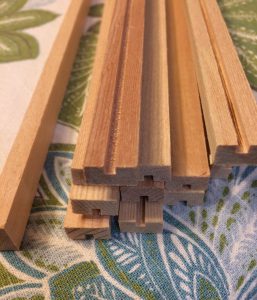Last night I ran another 20 sticks of geodetic capstrip stock through the sander. I had to adjust one of the guide boards for thickness; due to temperature and humidity changes it was too close to the drum by about .014 or so. So, 20 more down, a hundred or so to go. Sounds like a lot, but if I can do 20 in a night it’s another week before they’re all done. Then it’s just measuring, marking, and cutting them in stacks on the bandsaw. Over lunch today, in fact, I ran another ten through the process. It took about 40 minutes start to finish.
I can totally understand why people like plywood ribs. I could be knocking out plywood pieces, or more traditional braces for “normal” non-geodetic ribs. Would it be less work? Probably not. I’d still have to make precise cuts and no two pieces in a rib would be identical. There might be fewer of them, but with this method at least I have a very small amount of leeway on the exact length and angles. If a piece is 1/64″ or 1/32″ longer or shorter than the next, I can adjust the angle or position to make it fit without causing problems. I think wing ribs are just going to be a lot of repetitious work no matter how you do it. My only regret here is not calling Wicks or ACS on the phone to see if they would custom cut my capstrip to 1/32″, that would have saved a lot of work and waste.



